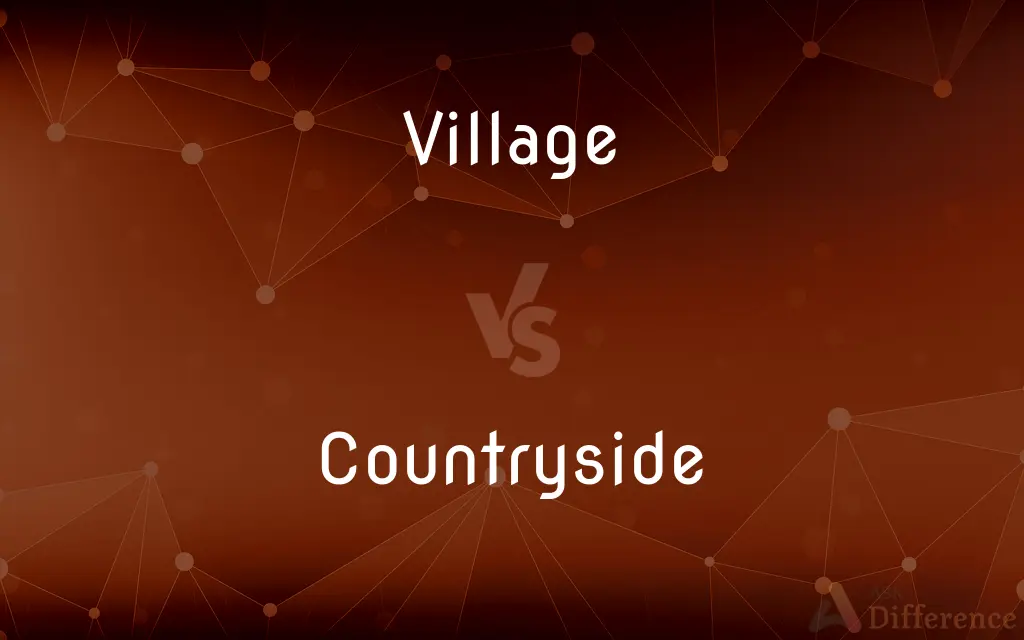Village vs. Countryside — What's the Difference?
By Urooj Arif & Maham Liaqat — Updated on April 5, 2024
A village is a small community with a concentrated population, whereas the countryside encompasses rural areas characterized by natural landscapes and low population density.

Difference Between Village and Countryside
Table of Contents
ADVERTISEMENT
Key Differences
A village represents a small settlement, often with a defined center such as a square or main street, surrounded by residential houses and essential local amenities. The countryside, on the other hand, refers to the wider rural area that includes villages, farms, forests, and undeveloped land, characterized by its natural scenery and open spaces.
While villages serve as nodes of human habitation and social interaction within the countryside, providing a sense of community and localized services, the countryside offers a broader context of rural life, with its vast agricultural lands, natural resources, and recreational areas. This distinction highlights the relationship between human settlements and the natural environment.
In terms of lifestyle, villagers often engage in activities that are closely tied to their community, such as local farming, small-scale trade, and communal gatherings. Conversely, the countryside lifestyle might be more isolated or spread out, with individuals and families living in farmhouses or small hamlets, engaged in agriculture, conservation, or enjoying the tranquility away from urban centers.
The economic basis of a village is usually centered around agriculture, local craftsmanship, and services that support the immediate community. Meanwhile, the countryside economy encompasses a wider range of agricultural activities, tourism, and sometimes light industry, which may not be centralized in any single settlement.
Despite their differences, both the village and the countryside are integral to the rural landscape, each offering unique insights into the relationship between communities and their natural surroundings, and together forming the fabric of rural life.
ADVERTISEMENT
Comparison Chart
Definition
A small, concentrated settlement.
Broad rural areas with natural landscapes.
Population
Relatively higher density than surrounding areas.
Lower density, spread over a larger area.
Lifestyle
Community-centric with local amenities.
Often isolated, focused on agriculture or nature.
Economic Basis
Agriculture, local trade, craftsmanship.
Agriculture, tourism, conservation.
Characteristics
Defined center, residential areas, local services.
Vast open spaces, farms, forests.
Compare with Definitions
Village
Small, clustered human settlement.
The village nestled in the valley hosts a close-knit community of families.
Countryside
Has a lower population density than urban areas.
The sprawling countryside is home to scattered homesteads and small communities.
Village
Has basic amenities and social institutions.
The village boasts its own school, post office, and a small marketplace.
Countryside
Refers to rural areas outside towns and cities.
The countryside is dotted with farms, forests, and open fields.
Village
Defined by a limited population.
With only a few hundred residents, the village maintains a tranquil atmosphere.
Countryside
Characterized by natural scenery and landscapes.
Rolling hills and verdant fields define the countryside's serene beauty.
Village
Serves as a social and economic hub in rural areas.
On market days, the village square becomes a bustling center of trade.
Countryside
Typically used for agriculture and leisure activities.
The countryside offers ample opportunities for hiking, cycling, and farming.
Village
Characterized by a more traditional lifestyle.
In the village, traditional festivals and customs are fervently preserved.
Countryside
Emphasizes a connection with nature and a slower pace of life.
Life in the countryside is marked by a peaceful rhythm and a close relationship with the natural environment.
Village
A village is a clustered human settlement or community, larger than a hamlet but smaller than a town (although the word is often used to describe both hamlets and smaller towns), with a population typically ranging from a few hundred to a few thousand. Though villages are often located in rural areas, the term urban village is also applied to certain urban neighborhoods.
Countryside
A rural region.
Village
A small group of dwellings in a rural area, usually ranking in size between a hamlet and a town.
Countryside
The inhabitants of a rural region.
Village
In some US states, an incorporated community smaller in population than a town.
Countryside
An area located outside of towns and cities; an area that is not urban or suburban; a rural area.
Village
The inhabitants of a village; villagers.
Countryside
Such part of a larger area.
We live in the Swedish countryside.
Village
A dense group of animal habitations
A prairie dog village.
Countryside
A rural landscape.
Village
A rural habitation of size between a hamlet and a town.
There are 2 churches and 3 shops in our village.
Countryside
A particular rural district; a country neighborhood.
Village
(British) A rural habitation that has a church, but no market.
Countryside
Rural regions
Village
(Australia) A planned community such as a retirement community or shopping district.
Village
(Philippines) A gated community.
Village
A small assemblage of houses in the country, less than a town or city.
Village
A community of people smaller than a town
Village
A settlement smaller than a town
Village
A mainly residential district of Manhattan; `the Village' became a home for many writers and artists in the 20th century
Common Curiosities
What is the main difference between a village and the countryside?
A village is a small settlement with a concentrated population, while the countryside refers to broader rural areas with natural landscapes and lower population density.
Can a village exist outside of the countryside?
While typically situated in rural areas, villages can also exist as distinct entities on the outskirts of urban areas, but they are generally associated with the countryside.
What types of activities are common in villages?
Common activities in villages include farming, local trade, community gatherings, and festivals.
What economic opportunities are available in the countryside?
The countryside offers opportunities in agriculture, tourism, conservation, and sometimes light industry or remote work.
How does living in the countryside differ from living in a village?
Living in the countryside may offer more isolation and a closer connection to nature, whereas village life tends to be more community-oriented with easier access to local services.
Are villages considered urban or rural?
Villages are considered rural due to their size, population density, and lifestyle, which are distinct from urban areas.
What are the benefits of living in a village?
Benefits include a close-knit community, a slower pace of life, and often a closer relationship with nature.
Why do people visit the countryside?
People visit the countryside for recreation, relaxation, and to experience nature and tranquility away from urban centers.
How is the infrastructure in the countryside?
Infrastructure can be less developed than in urban areas, with limited services but often includes essential roads, utilities, and internet access.
How do communities in villages and the countryside interact with their environment?
Both communities interact closely with their environment, often depending on it for livelihoods, recreation, and sustenance, though villages may have more built environments.
What challenges face villages and the countryside today?
Challenges include population decline, economic sustainability, loss of local services, and environmental conservation issues.
What role do villages play in the countryside?
Villages serve as focal points for community life, services, and social interaction within the broader countryside.
Can the countryside be developed?
While development occurs, it's often regulated to preserve the rural character, natural beauty, and agricultural land of the countryside.
How do villages contribute to the cultural identity of the countryside?
Villages often preserve traditional customs, crafts, and festivals, contributing significantly to the cultural identity of the countryside.
What is the impact of tourism on the countryside?
Tourism can provide economic benefits but may also pose challenges related to sustainability, environmental impact, and cultural preservation.
Share Your Discovery

Previous Comparison
Capsicum vs. Paprika
Next Comparison
Performance vs. AchievementAuthor Spotlight
Written by
Urooj ArifUrooj is a skilled content writer at Ask Difference, known for her exceptional ability to simplify complex topics into engaging and informative content. With a passion for research and a flair for clear, concise writing, she consistently delivers articles that resonate with our diverse audience.
Co-written by
Maham Liaqat















































